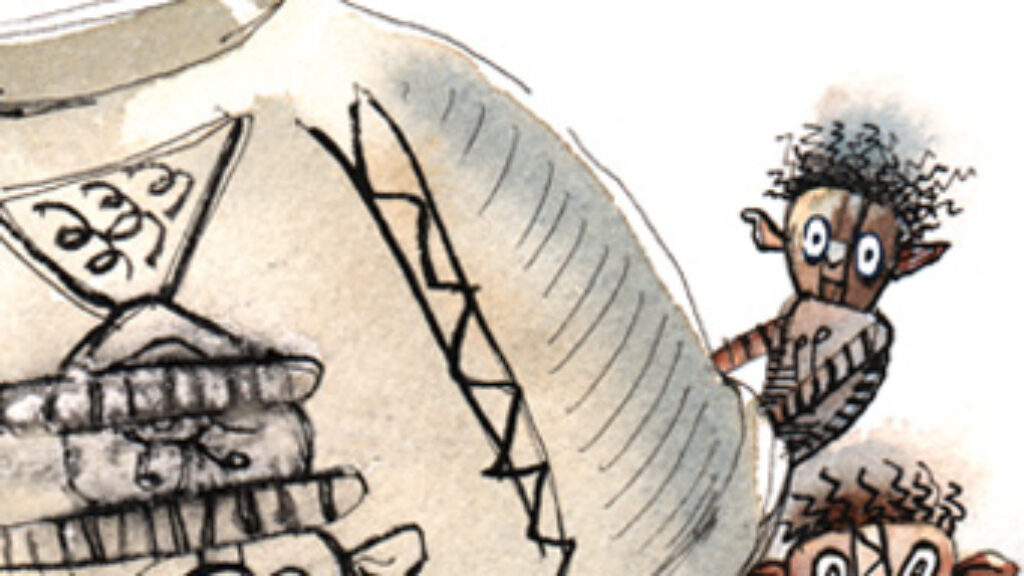Lilith and the Knight
In 2016, Gavriel Savit’s Anna and the Swallow Man won the National Jewish Book Council’s Goldberg Prize for a debut novel and was a finalist for the Young Adult award. His second and latest book has now won the latter category. Like his first novel, and like much of the American Jewish imagination, The Way Back is set in a mythologized Eastern Europe saturated with death. Yet Savit seems to be having fun in this Jewish fantasy, which starts off in a nineteenth-century shtetl before carrying us off to the demon-ruled land of the dead. The book has its weaknesses. Character motivations often feel arbitrary, the narrative is scattered, and the protagonists Bluma and Yehuda Leib are generic Plucky Child-Heroes with shtetl names attached. But there are dark delights along the way as each child searches for the soul of a family member.

In interviews, Savit has spoken of mining Jewish tradition for his fantasy, but he didn’t dig that deep. For instance, of the book’s four main supernatural characters, two are (to the best of my knowledge) imports from Christian, not Jewish myth. One, the demon lord Mammon, comes to us by way of Spenser’s Faerie Queene, while his fellow demon Dantalion mainly features in pseudo-Solomonic European books of spells. A third featured demon is the inevitable Lilith, though Savit has detached her from her premodern Jewish roots. She appears in the form of a cat and, moreover, mainly in her twentieth-century feminist incarnation, campaigning against arranged marriages. I have to read Savit as intending a critique of certain tendencies in modern feminism when one of the female characters says of the now-iconic demoness:
She makes a very compelling case when you first come into the Far Country—all about how you were deprived of opportunity in your life, how it makes sense for you to be angry, how you should decide not to move on, stay with her, join her Sisterhood. I bought it for a little while, but it’s all a lie. If you pay close enough attention, you’ll see: Lilith isn’t interested in anything but herself. . . . There is no Sisterhood, really—it’s all just different phases of Lilith.
The fourth otherworldly principal is Death, who Savit makes into a schlemiel. This hapless character has more affinities with Monty Python’s Grim Reaper than with Jewish legend’s Angel of Death.
The most Jewish of the book’s characters, so to speak, is the locale itself: the graveyard. Savit has taken the modern portrait of the shtetl world as a haunted place of death and decay and made it a lively ground for fantasy adventure. Savit’s Yeshiva of Despair is a descendent of the one in Bialik’s poem “Ha-masmid”; his trees hung with corpses are from Uri Zvi Greenberg’s pogrom poetry; and classic works of modern Jewish literature by I. L. Peretz—“The Dead Town” and A Night in the Old Marketplace—preside over the book. No wonder that one of the characters decamps to Sholem Aleichem’s Kasrilevke.
It is in this modern literary field—crosshatched throughout with non-Jewish influences, rather than in the more superficial gestures at Jewish demonology—that Savit offers his most vivid and memorable touches: the nameless demon “with eyes like drowning stars,” for instance, and the one “with hairy, twitching spiders instead of hands.” With the more directly Jewish materials, Savit is less consistent. We get a canny fantasy version of the Jewish cantonist brigades of the Russian Empire on the one hand; on the other, we get an episode with literal chicken soup for the soul.
Somewhat drowned out in the book’s scattershot ebullience is what I take as Savit’s neat Jewish rewriting of George MacDonald’s Victorian fantasy Lilith (her again). MacDonald’s novel taught that by embracing death, one could, through Christ, awaken to true, eternal life. By contrast, the wisdom Savit’s young heroes learn is that: “Each of us crosses the threshold of the House of Death, and each of us goes alone.” Not exactly an upbeat lesson, that. Savit suggests that the acceptance of death, however frightening, demands that we live in the here and now, stitching together eternity and responsibility. A rather Jewish lesson.
Moving from English-language book awards to Hebrew ones, and from the shtetl-and-Holocaust orbit of the American Jewish mind to the less predictable inventions of Israeli writers, we get Masha Zur-Glozman’s recent time-travel romance, Lehasbia et ha-drakon (Satisfying the Dragon), which won this year’s Geffen Award for original Hebrew work of fantasy or science fiction. This is the debut novel by Zur-Glozman, a writer for Ha’aretz and director of a documentary film about Amos Oz. Her protagonist, Idit, is a literary translator who has moved from Tel Aviv to the coastal town of Atlit, which boasts the ruins of a crusader castle (used today as a training area by the Israeli navy). While taking hallucinogenic mushrooms, Idit discovers a magic portal that transports her to the thirteenth century, where she commences a romance with the real-life nobleman and crusader Jean d’Ibelin.
Zur-Glozman is a deft writer, and the book starts out charmingly, a sort of “Tel Aviv hipster in King Arthur’s Court.” But the focus is less on the medieval than the contemporary, and most of the book is about Idit and her husband Shaul’s attempts to make their open marriage work. Idit’s dalliance with Jean, and the whole time-travel plot, turn out to be merely the fling she requires to salve her ego after Shaul breaks the rules of their polyamorous contract with a more serious affair. The novel is a brief for the protagonist’s open marriage; its fantasy a representation of her journey of discovery, which culminates in the realization that with a little magic, she can rise to the emotional challenges of polyamory.

What I found disappointing in the novel was not Idit and Shaul’s elastic definition of marriage but their banality. Idit’s daily existence consists of pot-smoking, artisanal cocktails, dropping her daughter off at daycare, and stepping out occasionally to a dance club or political protest or European capital for vacation. Her husband, who supports her financially and whose family conveniently bequeaths them their seaside villa, is supposed to be some kind of Israeli cultural figure. He is the editor of the feminist magazine Meshuchreret (Liberated Woman) and radio host of a successful arts and culture program. Yet neither he nor Idit evinces any interest in ideas, art, or culture apart from binging Netflix. Credentialed, progressive, and self-infatuated, they are perfect examples of today’s slightly-above-average-intelligence cultural elites.
Naturally, Idit’s Jewishness is of no import to her on either side of the portal—for that matter, neither are the Christian beliefs and practices of her lover—and she doesn’t even register curiosity about the medieval Jewish doctor who tends to the family of her courtly swain. Her crusader Jean is good in bed, and that’s all Idit needs to know about the thirteenth century. If treated as satire, the book’s premise would make excellent Israeli television, but this novel is earnest.
Interestingly, another book shortlisted for the same Geffen Award was Haim Navon’s Hofshi zeh (Free), a dystopian science fiction novel about a future Israel in which all human relationships are based on conditional and temporary contracts, including those between parents and children: the ultimate triumph of liberal autonomy. The result is predictably bleak. Yet that future seems already here in Zur-Glozman’s Idit, who judges everything, including medieval crusader kingdoms, by how easily they gratify her appetites. Like Savit’s Lilith, she “isn’t interested in anything but herself.”
Suggested Reading

“With a Wolf in One Eye”: Sutzkever in Israel
From his birth just outside Vilna in 1913, Abraham Sutzkever led a life that had merged, as though on a God-ordained path, with the fate of the Jewish people in the 20th century. It of course follows that that life would reach its culmination in Israel.

Common Clay
Virtually nothing of Babylonian Jewry of the talmudic period, from the 3rd to the 6th century C.E., has survived beyond the Babylonian Talmud itself to help contextualize or confirm the many things the text tells its readers.
On Old Stones, a Black Cat, and a New Zion
There is a legend that Prague’s Altneuschul was built on a foundation of stones from the ancient Temple in Jerusalem.
Why There Is No Jewish Narnia
So why don’t Jews write more fantasy literature? And a different, deeper but related question: why are there no works of modern fantasy that are profoundly Jewish in the way that, say, The Lion, the Witch, and the Wardrobe is Christian?
Comments
You must log in to comment Log In